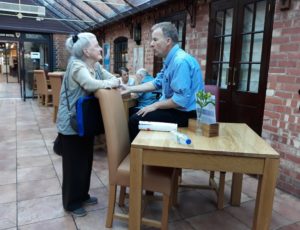This collaboration started in 2014, inspired by the Warwickshire-based Atherstone Civic Society and Friends of Atherstone Heritage. They wished to progress work on the unpublished archive from Kay Hartley’s 1960s-70s excavations of the Roman pottery production site at Mancetter-Hartshill and approached Roman pottery specialists at Worcestershire Archive and Archaeology Service (WAAS) for advice.
The importance of the archive was widely recognised. Its publication was identified as a priority in national and regional Research Frameworks. The kilns span the Warwickshire and Leicestershire border and the west and east midlands Regional Research areas, with significant trade to northern Britain.
The first step was a visit to Warwickshire Museum store to see the archive. In 2015-16, Laura Griffin and Jane Evans presented papers at conferences, developing their ideas, targeting different audiences and promoting a collaborative approach (CIfA; Study Group for Roman Pottery (SGRP); Society for Museum Archaeology (SMA); CBA West Midlands day-school and summer field day at Mancetter.
A CBA West Midlands research grant facilitated a meeting of interested parties; from Warwickshire County Council (HER and planning), Warwickshire Museums, the Atherstone Civic Society, SGRP, CBA West Midlands, WAAS, and James Gerrard of Newcastle University. While not based in the region, James Gerrard has a relevant research interest and his university department actively promotes material culture studies. The grant highlighted the importance placed on the archive by the West Midlands Archaeological community. In 2017 WAAS approached Historic England for funding. The audit and project design were completed in 2018 and the digitisation early in 2020.
The archive is with ADS and will go online in 2020. This will complement a separate, important project, digitising Kay Hartley’s mortaria stamp archive. There are ideas for a Collaborative Doctoral Award (James Gerrard and Eniko Hudak), building on the archive. This will contribute to academic research and commercial archaeology, filling a recognised skills gap. There is now potential for University of Leicester specialists to research pottery supply from Mancetter-Hartshill to Roman Leicester. The 2019 SGRP conference, hosted in Atherstone, showcased the archive; papers will be published in the Journal of Roman Pottery Studies (JRPS). Positive feedback was received from Kay Hartley and the academics, commercial archaeologists and local community who attended. The Atherstone Civic Society and Friends of Atherstone Heritage have subsequently opened a ‘Roman Mancetter and Boudica Heritage Centre,’ displaying pottery from the kilns. Margaret Hughes from Atherstone Civic Society noted ‘I am constantly stressing the link with your work, and your colleagues’ work, in every presentation we make. I constantly keep in mind that meeting (supported by the CBA West Midlands Research Grant) with interested people from a wide range of specialist institutions.’
What has been learnt? Collaboration is beneficial to all. This has been a loose collaboration; like a Venn diagram, collaborators have shared some overlapping interests but diverged in others. Collaboration relies on committed individuals. Institutions and interest groups can establish frameworks and priorities, and provide funding, support, and opportunities for individuals to interact. Individuals need to reach out, sharing ideas at conferences, getting feedback and making connections. Some of the best collaborations develop from conversations in conference tea breaks. And finally, be open to opportunities that may further your aims.
You can access the Mancetter-Hartshill online archive here.

Bringing together senior members of staff from public and non-government bodies to work collaboratively on strategic matters for the historic environment sector.